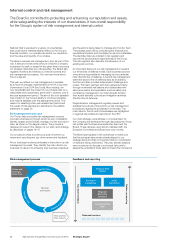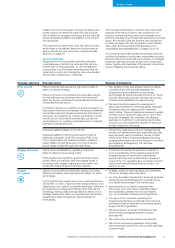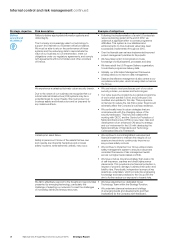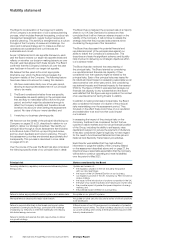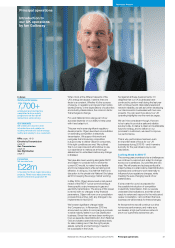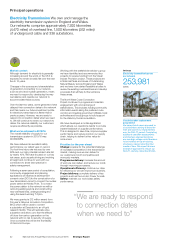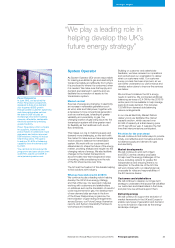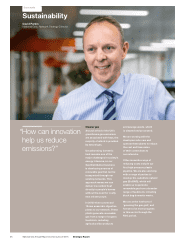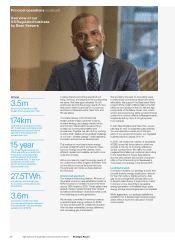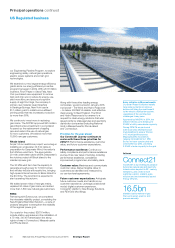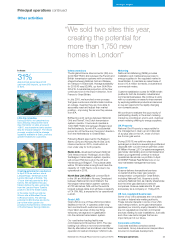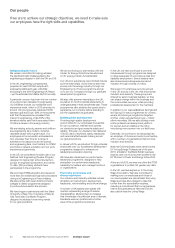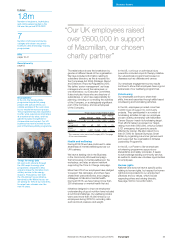National Grid 2016 Annual Report Download - page 37
Download and view the complete annual report
Please find page 37 of the 2016 National Grid annual report below. You can navigate through the pages in the report by either clicking on the pages listed below, or by using the keyword search tool below to find specific information within the annual report.
Building on customer and stakeholder
feedback, we have reviewed our operations
and restructured our organisation to deliver
what our customers need. Our customer
survey process has been improved, so we
can better understand our performance and
develop action plans to improve the services
we deliver.
We continue to balance the UK’s energy
needs in real time. We contracted additional
balancing services of 2.4 GW for the 2015/16
winter period to be available to help manage
periods of peak demand. This includes
133 MW from demand side balancing
reserve arrangements.
In our role as Electricity Market Reform
delivery body we facilitated the market
capacity auction, which secured over
46 GW of capacity at a final clearing price
of £18 per kW per year. It was also the first
time that interconnectors participated.
Priorities for the year ahead
We will continue to find better ways to provide
timely, cost effective and innovative solutions
to balance supply and demand for gas
and electricity.
Market developments
We will continue to work with Ofgem
and DECC as they develop proposals
to help meet the energy challenges of the
future, including options for greater SO
independence and ensuring there is no
disruption to the vital role of the SO. We
will work closely with our stakeholders as
proposals for roles and responsibilities of
the SO become clearer.
Customers and stakeholders
We will continue to develop our longer-term
strategy to understand the issues that will affect
our customers and stakeholders in the future,
and plan how we will best support them.
Delivering energy
We will continue to support the evolution of
market frameworks in the UK and Europe to
enable new types of generation and demand
to come forward in response as the energy
landscape changes.
System Operator
As System Operator (SO) we are responsible
for making sure Britain’s gas and electricity is
transported safely and efficiently from where
it is produced to where it is consumed, when
it is needed. We make sure that supply and
demand are balanced in real time and we
facilitate the connection of assets to the
transmission system.
Market context
Sources of energy are changing. In electricity,
an increase in renewable generation such
as wind, solar and tidal power, together with
a decrease in more conventional generation
such as coal and gas, is leading to greater
variability and uncertainty. In gas, the
changing location of gas being input into the
transmission system will drive greater need
for flexibility as the traditional north-south
flow diminishes.
This makes our role in matching supply and
demand more challenging, so we work with
the market to make sure we have appropriate
tools in place to balance the transmission
system. We work with our customers and
stakeholders to shape the future of the energy
market, providing analysis and insight into the
changing nature of energy. We also facilitate
changes to the market frameworks to
accommodate new technologies and ways
of working, while considering how the role
of the SO should evolve over time.
The SO is at the forefront of this debate helping
to find solutions with industry.
What we have delivered in 2015/16
We continue to play a leading role in helping
develop the UK’s future energy strategy,
and that of Europe. Our approach includes
working with customers and stakeholders
on initiatives such as the translation of new EU
code requirements for gas, the development
of new demand side services in the form
of the Power Responsive programme, the
harmonisation of gas trading arrangements
across Europe, our Future Energy Scenarios
reports, and System Operability Framework
workshops and webinars.
Power Responsive
In June 2015, we launched the
Power Responsive programme,
designed to help drive demand
side response (DSR) growth
through greater customer awareness
and clear participation policies.
We believe DSR will play an
increasingly vital role in building
a secure, affordable, sustainable
electricity system by providing
greater exibility.
Power Responsive offers a means
for suppliers, businesses and
policy makers to collaborate, build
awareness and deliver improved
DSR solutions, helping to reduce
total energy costs. The goal is
to achieve 30–50% of balancing
capability from the demand side
by 2020.
You can nd out more about the
programme and case studies from
customers signed up to DSR at
www.powerresponsive.com
“ We play a leading role in
helping develop the UK’s
future energy strategy”
35National Grid Annual Report and Accounts 2015/16
Strategic Report
Principal operations



